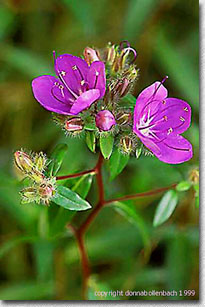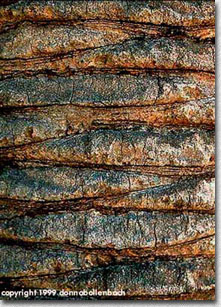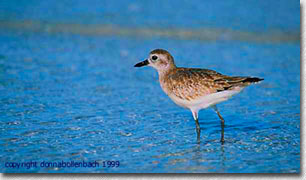|
|
 Feature Article... May the Art be With You
Text Copyright and Photography Copyright Donna Bollenbach
My response was “THANKS for the reminder. I have been going through one of those rote photography periods and I have been wondering what’s missing. I think I too need to get the art back in my images.” I then begin to consider what makes a nature photography image artistic. To begin, as a nature photographer I feel I am less a creator of art than an interpreter. I believe the core of all art exists in Nature and if one has the eye to recognize it they have the potential to make great images. Whether it is the slope of a hill, the shape of a flower, or an animal poised for action, nature is full of artistic compositions. Capturing the artistic qualities on film is the challenge of the nature photographer. “We do not see nature with our eyes, but with our understandings and our heart.”
Strong composition is important to artistic interpretation. Placement of the elements in the photo and angle of view work together to create a balance that conveys our vision: calm vs. tension; large vs. small; far vs. near. But good composition is more than placement, perhaps more importantly it is the conscious decision by the photographer as to what to include and exclude from the viewfinder. Before releasing the shutter, explore all corners of your viewfinder and ask yourself if there is any extraneous or distracting information inside. Then simplify, simplify and simplify some more. To ere on the side of simplification is probably best, because as in nature, nature photographers produce the greatest results with the simplest means. “Science will never be able to reduce the value of a sunset to arithmetic."
WHY do I want to take this photograph? (What elements attracted me to this scene? What should I include and exclude? What feelings do I want my image to evoke?) HOW can I best express what I see? (What perspective should I use? How should I place the elements? What is the simplest means to get the results I want?) Not all nature images have to be a work of art. You may just want to get a record shot-to identify a subject. In that case you will need to include all the details you can. Selective focus on the blossom of a flower, without a clear picture of the leaves would make identification difficult. Likewise, the simplest means of expressing what you see may involve an elaborate set-up and multiple photographic techniques. But at least, by exploring your options you are putting the horse before the cart, the image before the technique, the thought before the action. Now, if the little voices in your head are asking you the same questions as mine, you are probably wondering how you can put all this into practice when heard of wild horses thunder through a golden field. By the time you’ve asked and answered all the questions, they’re gone! The answer is simple (there’s that word again.): practice, practice, and practice. If you know you are going out to shoot wild horses, ask the questions before you go out on the shoot. Envision the photograph you want to get. Envision the ideal situation to get that photo. The more you think about these things the more likely you are to capture the image if it presents itself. Even when surprised by a deer that suddenly bounds into the meadow, you will be ready. Art, like technique, is learned through application. Experiment, don’t be afraid to make mistakes, study the results and try, try again! “Nature never deceives us; it is always we who deceive ourselves.” About the images... Skyflower…Why? This image combines Shape, Lines and Form to lead your eye through the to the subject. While the stem of the flower appears centered, the blossoms are placed in strategic focal points. How: Nikon F90x, 200mm macro, selective focus, natural, overcast light. Palm Tree Bark Texture…Why? I was attracted to the natural repetition of lines and light to create texture. Lines, used effectively, will carry the eye through the frame. How? Nikon N50, 60mm macro lens held parallel to the subject, natural light. Black-bellied Plover…Why? Simplicity; there is a bird, there is water. Lack of distracting elements and placement of the bird in the lower right of the frame focuses attention on the bird. How: Nikon F90x, 300mm, tripod lowered to nearly ground level, natural light. (Note:: It is almost always better to put more space in the direction your subject is facing or else the subject may seem too cramped in the frame.) This is part one of a series where Donna explores the “Art” of Photography. In part two, she will study Sculpturing images with Shape, Form and Light. |
|
|
 A friend once expressed to me that “very few people in nature photography take the ‘art’ seriously.” He continued, “Most of us are so obsessed with technique or the thrill of being there that we tend to forget the final image is usually better if it has some merit as graphical art.”
A friend once expressed to me that “very few people in nature photography take the ‘art’ seriously.” He continued, “Most of us are so obsessed with technique or the thrill of being there that we tend to forget the final image is usually better if it has some merit as graphical art.” What makes an image artistic? Since art is so subjective, this could be a very personal question with as many answers as there are nature photographers. My own thought is artistic photos evoke feelings: The warmth we experience when viewing pictures of a sunset; the soft, cuddly feelings associated with images of rabbits and panda bears; the awe we sense when viewing expansive mountain landscapes; and the fascination we feel when presented with a close-up of an insect catching its prey. But, even a mediocre picture can evoke some feelings, so what makes a photo a work of art?
What makes an image artistic? Since art is so subjective, this could be a very personal question with as many answers as there are nature photographers. My own thought is artistic photos evoke feelings: The warmth we experience when viewing pictures of a sunset; the soft, cuddly feelings associated with images of rabbits and panda bears; the awe we sense when viewing expansive mountain landscapes; and the fascination we feel when presented with a close-up of an insect catching its prey. But, even a mediocre picture can evoke some feelings, so what makes a photo a work of art? So, this is all wonderful in theory, but how do we make it happen? How do I get the art back in my nature photography? Well, lets look at my friends comment, “Most of us are so obsessed with technique or the thrill of being there we tend to forget…the art.”
I am guilty. I get so excited when I find a great subject, I lose perspective and it shows in my images. To recapture my artistic vision, I ask myself a few simple questions before I release the shutter:
So, this is all wonderful in theory, but how do we make it happen? How do I get the art back in my nature photography? Well, lets look at my friends comment, “Most of us are so obsessed with technique or the thrill of being there we tend to forget…the art.”
I am guilty. I get so excited when I find a great subject, I lose perspective and it shows in my images. To recapture my artistic vision, I ask myself a few simple questions before I release the shutter: